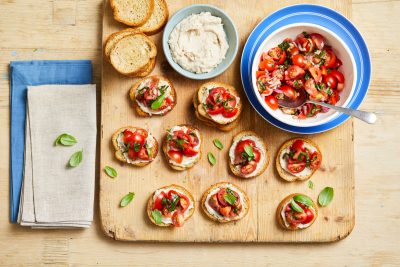HEART FOUNDATION LAUNCHES ‘LUNCHBOX LIFESAVER’ TIPS FOR A HEALTHY RETURN TO SCHOOL
The Heart Foundation is on a mission to help parents and school kids prepare their healthiest – and tastiest – lunchboxes yet, as 4 million Australian students get ready to head back to school.
Tips such as making sandwiches with one slice of whitebread and one slice of wholemeal bread can help to introduce healthier eating habits to students, keeping them fuller for longer and helping

to reduce obesity rates.
In Australia, a quarter of all Australian kids aged 5 to 14 years are overweight1. Additionally, many fail to meet the daily recommended servings of fruit, vegetables and legumes – foods that are essential to establishing healthy eating habits and reducing their future risk of heart disease.
Research also shows that kids are exposed to more than 15 junk food advertisements per hour when online, making it tough for parents to reinforce healthy eating.2
HOW DO I HELP MY CHILD ENJOY EATING HEALTHY?
The key, according to Heart Foundation senior dietitian Jemma O’Hanlon, is to take small steps towards a bigger goal.
Today, Ms O’Hanlon shared the organisation’s top lunchbox lifesavers to keep costs down for families and satisfy their kids’ tastebuds while sticking to heart-healthy eating habits.
LUNCHBOX LIFESAVERS
- Eat the rainbow
- Eat a variety of vegetable and fruit colours for maximum nutritional value.
- Make a zebra sandwich
- Combine one slice of healthy bread with one slice of white bread to transition to a wholegrain based sandwich.
- Ensure food is easy for little fingers to eat
- Smaller sizes are easier to eat and give a sense of achievement.
- Prioritise your plan
- Make time ensure you have what you need, and time to prepare it – with your kids – to be consistent.
- Include a frozen water bottle
- Hydration is important, particularly with additional fibre intake.
Ms O’Hanlon said to remember that food choices are not necessarily good or bad in isolation; they instead need to be considered in the context of our whole diets.
“Parents are busy enough, so don’t feel that you need to spend hours in the kitchen preparing lunches. Have your little helpers give you a hand and let them choose which fruit or vegetable they would like to pack in their lunchbox,” she said.
“If you want to give your child a treat, choose one day of the week (Friday is always a popular choice) and let them choose a ‘sometimes food’ to add to their lunchbox.
“It’s also important to remember, if food comes home uneaten, don’t be defeated because it can take over 10 times of offering a child a food before acceptance.“
For some simple and tasty kid-approved recipes, visit our kid friendly recipes webpage on the Heart Foundation website.
Heart Foundation funding research into junk food advertising exposure
Heart Foundation funded researcher, Professor Kathryn Backholer, from Deakin University, is currently investigating the impact of junk food advertising on how young minds make eating decisions.
“We live in a rapidly changing, digital world, where children’s and young adults’ exposure to the marketing of unhealthy snacks and brands is unprecedented,” Prof. Backholer said.
“Existing evidence has shown that routine exposure to things like unwholesome food or drink negatively influences attitudes and behaviour, and therefore cardiovascular health and wellbeing.
“We hope that our research, that is focussed on the digital space, makes it easier for parents to provide their kids with a healthy diet, by reducing the influence of marketing for children in the area of food because at the moment, hyper-targeted online junk food advertisements pose a serious health-risk.”
Prof. Backholer and her team believe effective monitoring systems, that can track the highly targeted and personalised digital food and drink ads, will provide vital information that will inform regulatory frameworks – and in turn empower parents.
Given unhealthy diets are a leading risk factor for cardiovascular disease, the Heart Foundation’s senior dietitian, Jemma O’Hanlon said it’s important for families to take small, easy steps towards a healthier lifestyle – and involve the kids.
“Given one in four children living in Australia are overweight or obese, the school lunchbox is a good place to start,” Ms O’Hanlon said.
ENDS
References
1. Australian Institute of Health and Welfare, Australia’s Children, Overweight and Obesity, 25 February 2022, accessed online January 2023. https://www.aihw.gov.au/reports/children-youth/australias-children/contents/health/overweight-obesity
2.Kelly B, Bosward R, Freeman B, Australian Children’s Exposure to, and Engagement With, Web-Based Marketing of Food and Drink Brands: Cross-sectional Observational Study
J Med Internet Res 2021;23(7):e28144
doi: 10.2196/28144
FURTHER BACKGROUND AND NOTES FOR YOUR STORY
Lunchbox lifesavers explained
Eat the rainbow
Is there colour and variety? Chopped vegetables like carrot, celery, cucumber and capsicum make the lunchbox fun and colourful. If you can get your hands on a lunchbox with compartments, you could add olives, nuts cheese, wholegrain crackers, and healthier dips like hummus and tzatziki – the kids will feel fuller for longer and their hearts will thank you.
Make a zebra sandwich
Use one slice of white bread and one slice of wholemeal for a lunchtime sandwich – it’s a great way to start introducing healthier bread if your kids aren’t used to it. You could also try rye, linseed, high fibre white or pita pockets and Lebanese wraps. Wholegrain foods (like brown rice, wholemeal pasta, grainy bread and oats) are full of fibre. Swapping from refined grains like white bread and white rice to wholegrain versions is a simple change that can improve the diet of the whole family.
Make food easy for little fingers to eat
Pack a handful of dried fruit, seasonal berries or rub lemon juice on cut fruit (which stops it from going brown; so it still looks appetising by morning tea time). For the best value for money, look out for seasonal fruit that’s on special, or give canned fruit in 100% natural juice a go – it’s a great option because they come in single serve tubs.
Prioritise your plan
Unhealthy snacks targeted to young children (eg snack-size chips and biscuits) and sugary drinks lack important nutrients and are often high in sodium or added sugar; they can also be very expensive. Instead, try to plan the lunchboxes for the whole family, making a list of everything you need. Do an inventory of the pantry before doing the shopping and only buy what you are going to use; this reduces waste and saves money.
Include a frozen water bottle
It will help keep their lunch cool, safe and provide an icy cold drink. Water should be the main drink of the day for kids to stay hydrated.
For specialised advice based on your child’s individual needs, see an Accredited Practising Dietitian.




